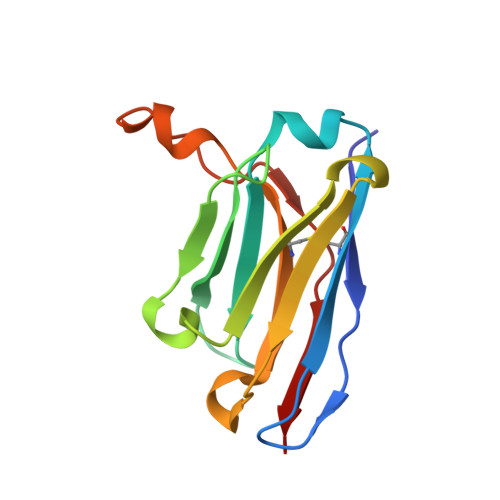Structure and characterization of a high affinity C5a monoclonal antibody that blocks binding to C5aR1 and C5aR2 receptors.
Colley, C.S., Popovic, B., Sridharan, S., Debreczeni, J.E., Hargeaves, D., Fung, M., An, L.L., Edwards, B., Arnold, J., England, E., Eghobamien, L., Sivars, U., Flavell, L., Renshaw, J., Wickson, K., Warrener, P., Zha, J., Bonnell, J., Woods, R., Wilkinson, T., Dobson, C., Vaughan, T.J.(2018) MAbs 10: 104-117
- PubMed: 28952876
- DOI: https://doi.org/10.1080/19420862.2017.1384892
- Primary Citation of Related Structures:
4UU9 - PubMed Abstract:
C5a is a potent anaphylatoxin that modulates inflammation through the C5aR1 and C5aR2 receptors. The molecular interactions between C5a-C5aR1 receptor are well defined, whereas C5a-C5aR2 receptor interactions are poorly understood. Here, we describe the generation of a human antibody, MEDI7814, that neutralizes C5a and C5adesArg binding to the C5aR1 and C5aR2 receptors, without affecting complement-mediated bacterial cell killing. Unlike other anti-C5a mAbs described, this antibody has been shown to inhibit the effects of C5a by blocking C5a binding to both C5aR1 and C5aR2 receptors. The crystal structure of the antibody in complex with human C5a reveals a discontinuous epitope of 22 amino acids. This is the first time the epitope for an antibody that blocks C5aR1 and C5aR2 receptors has been described, and this work provides a basis for molecular studies aimed at further understanding the C5a-C5aR2 receptor interaction. MEDI7814 has therapeutic potential for the treatment of acute inflammatory conditions in which both C5a receptors may mediate inflammation, such as sepsis or renal ischemia-reperfusion injury.
Organizational Affiliation:
a Antibody Discovery and Protein Engineering, MedImmune Ltd , Cambridge , UK.

















